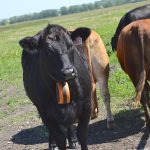Rethinking herbicide use Group of scientists say stacking herbicides with resistant genes focuses only on short-term gains
A split in opinion about the merits of stacking herbicide tolerance genes on top of existing technology is brewing controversy within North America’s weed science profession.
A group of Canadian and American weed scientists is openly challenging the prevalent wisdom that crops with two or more herbicide tolerant traits will remedy the problem of herbicide resistant weeds.
The Canadian Food Inspection Agency approved a DowAgroSciences technology last year that combined 2,4-D tolerance with glyphosate tolerance. Dow expects to launch its Enlist weed control system for corn in 2013 and soybeans in 2015, pending approval in the United States.
Read Also

Why feds imposed EV tariffs
Moe and Kinew have a fight on their hands when it comes to eliminating the EV tariff. Canada has to worry about pissing off the U.S. and Mexico and hundreds of thousands of auto workers.
Meanwhile, Monsanto expects to introduce genetically modified soybean seed next year that combines dicamba tolerance with its Roundup Ready technology
In a paper published last year in Weed Science, four Agriculture Canada weed scientists and two professors at American universities said it makes little sense to combat the problem of glyphosate resistant weeds by throwing more herbicides at the problem.
“Why are so many weed scientists and extension personnel recommending more herbicides to mitigate herbicide resistance problems?” their paper asked.
Neil Harker, an Agriculture Canada researcher in Lacombe, Alta., and lead author of the Weed Science paper, said only a few people in the weed science community are asking tough questions about stacked technology.
“There is a definite split. It’s best characterized by saying there are those that … (think) we should change directions a bit.”
Harker and fellow Agriculture Canada scientists John O’Donovan, Hugh Beckie and Robert Blackshaw argue in the paper that stacked resistant genes will have short-term benefits. In the longer term, the technology and overuse of herbicides will lead to weeds with resistance to a long list of herbicides.
Instead, Harker said scientists should be studying alternative methods of controlling weeds to slow the evolution of resistance and preserve existing herbicides.
David Mortensen, a plant science professor at Penn State university, said scientists and growers should pause and evaluate all options before continuing down the path of more technology and more herbicides.
“If we entrench agricultural practices to choices that are largely herbicide solutions … we’re concerned that we will start closing doors on the alternatives that could be used by farmers,” he said.
Mark Peterson, global biology team leader for Dow’s Enlist technology, said it is another tool to fight weed resistance. He doesn’t agree that it exacerbates the problem.
“There shouldn’t be too much controversy to bringing new tools to diversify weed management,” he said.
“There’s a range of opinions of the issue of weed resistance management…. The broad consensus of the weed science community, in terms of how to address herbicide resistant weeds, is to increase diversity of weed management.”
Bruce Maxwell, a land resources and environmental sciences professor at Montana State University, said part of the problem is the Weed Science Society of America (WSSA), a professional association.
Weed scientists employed by major crop protection companies dominate the WSSA agenda, he said.
As a result, producers and the public shouldn’t be surprised that corporate profit is driving the science within the weed science profession, he added.
“It’s sort of a mouthpiece for industry in many respects. And many scientists are reluctant to expose problems with chemistries because they are sort of beholden to these folks (corporations) in different ways,” he said.
To illustrate the inordinate attention that weed scientists pay to herbicides, Harker and O’Donovan, reviewed journal articles published from 1995 to June 1, 2012. They found that weed scientists wrote hundreds of articles on herbicides but only dozens of papers on integrated weed management (IWM), which uses multiple tools to control weeds.
“The number of articles that weed scientists publish is 10 to one, herbicides vs. alternative technologies,” Harker said.
Weed scientists study herbicides because they are the most effective and easiest tool to control weeds, he added, while alternative tools such as weed seed destruction, intensive seeding rates and intercropping are less effective and not well understood.
However, as Harker asked in a paper that will appear in Weed Technology in 2013, why aren’t more scientists studying alternatives to herbicides, considering that glyphosate resistance has been a big issue in North America for a number of years?
However, Peterson said weed scientists employed by major crop protection companies are trained at publicly funded universities.
Therefore, it’s incorrect to assume that corporate weed scientists are attempting to stifle independent research, which promotes alternatives to herbicides.















